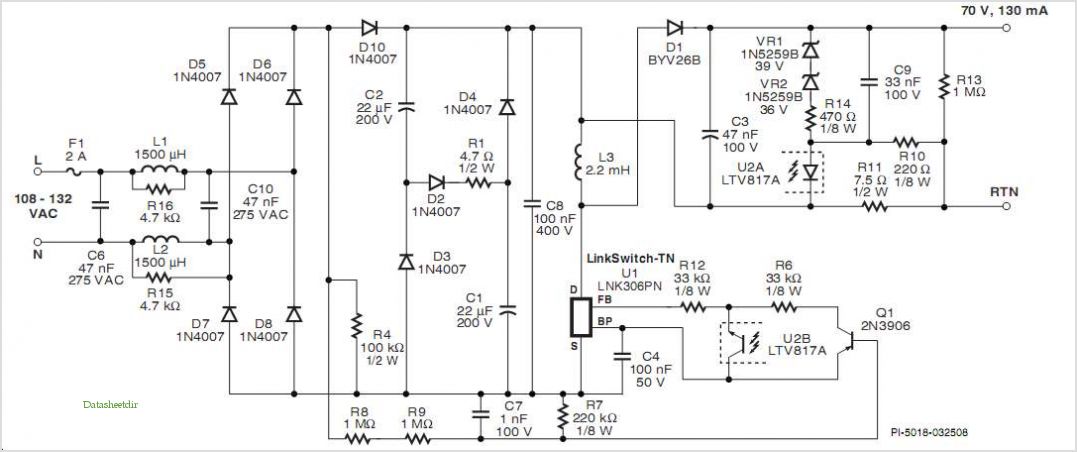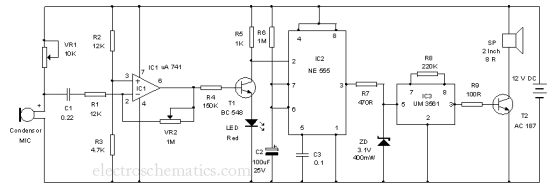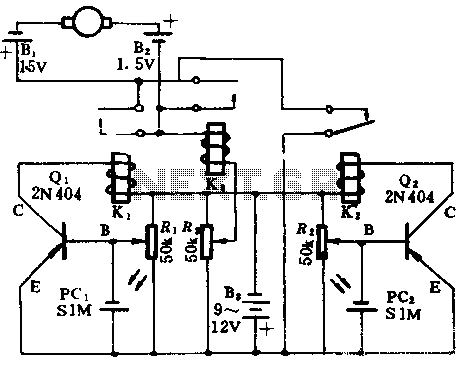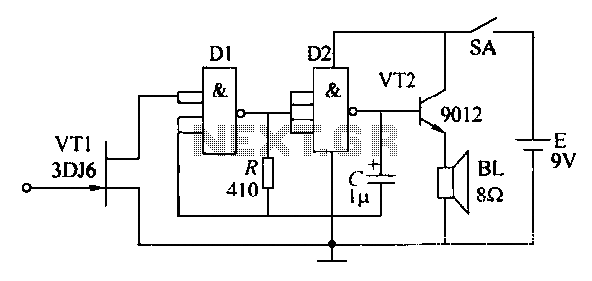
Low Cost Dimmable Led Ballast Using The Valley Fill Current Shaping Circuit

The BFP640 transistor is utilized for 1575 MHz Global Positioning Satellite (GPS) applications, specifically as a Low Noise Amplifier (LNA). The design objectives include a minimum gain of 16 dB, a noise figure of less than 0.6 dB, an input/output return loss of 10 dB or better, and a current draw of less than 10 mA from a 3.0-volt power supply. The printed circuit board (PCB) used is Infineon Part Number 640-061603 Rev A, constructed from standard FR4 material in a three-layer configuration. Low-cost, standard "0402" case-size surface-mount technology (SMT) passive components are employed throughout the design. The LNA exhibits unconditional stability from 5 MHz to 6 GHz, with a total PCB area of approximately 35 mm² dedicated to the single LNA stage. The total parts count, including the BFP640 transistor, is 12. The design achieved a gain of 17 dB and a noise figure of 0.92 dB at 1575 MHz from a 3.0 V supply, drawing 8.3 mA. It should be noted that the noise figure result does not account for FR4 PCB losses; if the PCB loss at the LNA input were extracted, the noise figure would be approximately 0.2 dB lower. The amplifier is unconditionally stable across the specified frequency range, with an input P1dB of -13.1 dBm at 1575.4 MHz and an impressive input third-order intercept point of +7.7 dBm.
The BFP640 transistor serves as a critical component in the design of a Low Noise Amplifier for GPS applications operating at 1575 MHz. The primary goal is to enhance the signal received from GPS satellites while maintaining low noise levels to ensure signal integrity. The design specifications are rigorously defined, with a target gain of at least 16 dB to amplify weak signals effectively, while the noise figure threshold of 0.6 dB or lower is crucial to minimize additional noise introduced by the amplifier itself.
The choice of a three-layer FR4 PCB, identified as Infineon Part Number 640-061603 Rev A, provides a robust foundation for the circuit, facilitating effective signal routing and grounding. The use of standard "0402" case-size SMT passive components not only contributes to the compactness of the design but also ensures cost-effectiveness. The layout is optimized for performance, with careful consideration given to the placement of components to minimize parasitic inductance and capacitance.
The LNA's unconditional stability across the frequency range from 5 MHz to 6 GHz is particularly noteworthy, as it ensures reliable operation without the risk of oscillations, which could degrade performance. The choice of components and the PCB design work together to achieve a total area of approximately 35 mm² for the LNA stage, making it suitable for integration into compact GPS receivers.
The amplifier's performance metrics are impressive, achieving a gain of 17 dB and a noise figure of 0.92 dB at the target frequency, with a current consumption of 8.3 mA from a 3.0 V supply. The acknowledgment that the noise figure does not account for PCB losses is critical for understanding the overall performance; the potential reduction of approximately 0.2 dB highlights the importance of accounting for all elements in the signal path.
Furthermore, the input P1dB of -13.1 dBm at 1575.4 MHz indicates the amplifier's ability to handle input power levels effectively, while the input third-order intercept point of +7.7 dBm demonstrates its linearity and capacity to manage intermodulation distortion, which is vital for maintaining signal clarity in multi-signal environments. This comprehensive design approach ensures that the BFP640-based LNA meets the stringent requirements of modern GPS systems.BFP640 used for 1575 MHz Global Positioning Satellite (GPS) Applications BFP640 is investigated for use as an LNA for 1575 MHz GPs Design Goals: Gain = 16 dB min, Noise Figure < 0. 6 dB, Input / Output Return Loss 10 dB or better, current < 10 mA from a 3. 0 Volt power supply, Input P1dB > -14. 8 dBm min Printed Circuit Board used is Infineon Part Number 640-061603 Rev A. Standard FR4 material is used in a three-layer PCB. Please refer to cross-sectional diagram. Low-cost, standard "0402" case-size SMT passive components are used throughout. Please refer to schematic and Bill Of Material. The LNA is unconditionally stable from 5 MHz to 6 GHz. Total PCB area used for the single LNA stage is approximately 35 mm ². Total Parts count, including the BFP640 Transistor is 12. Achieved ‰… 17 dB gain, 0. 92 dB Noise Figure at 1575 MHz from 3. 0 V supply drawing 8. 3 mA. Note noise figure result does NOT "back out" FR4 PCB losses - if the PCB loss at LNA input were extracted, Noise Figure result would be approximately 0. 2 dB lower. Amplifier is unconditionally stable from 5 MHz to 6 GHz. Input P1dB ‰ -13. 1 dBm @ 1575. 4 MHz. Outstanding Input Third Order Intercept of +7. 7 dBm. 🔗 External reference
The BFP640 transistor serves as a critical component in the design of a Low Noise Amplifier for GPS applications operating at 1575 MHz. The primary goal is to enhance the signal received from GPS satellites while maintaining low noise levels to ensure signal integrity. The design specifications are rigorously defined, with a target gain of at least 16 dB to amplify weak signals effectively, while the noise figure threshold of 0.6 dB or lower is crucial to minimize additional noise introduced by the amplifier itself.
The choice of a three-layer FR4 PCB, identified as Infineon Part Number 640-061603 Rev A, provides a robust foundation for the circuit, facilitating effective signal routing and grounding. The use of standard "0402" case-size SMT passive components not only contributes to the compactness of the design but also ensures cost-effectiveness. The layout is optimized for performance, with careful consideration given to the placement of components to minimize parasitic inductance and capacitance.
The LNA's unconditional stability across the frequency range from 5 MHz to 6 GHz is particularly noteworthy, as it ensures reliable operation without the risk of oscillations, which could degrade performance. The choice of components and the PCB design work together to achieve a total area of approximately 35 mm² for the LNA stage, making it suitable for integration into compact GPS receivers.
The amplifier's performance metrics are impressive, achieving a gain of 17 dB and a noise figure of 0.92 dB at the target frequency, with a current consumption of 8.3 mA from a 3.0 V supply. The acknowledgment that the noise figure does not account for PCB losses is critical for understanding the overall performance; the potential reduction of approximately 0.2 dB highlights the importance of accounting for all elements in the signal path.
Furthermore, the input P1dB of -13.1 dBm at 1575.4 MHz indicates the amplifier's ability to handle input power levels effectively, while the input third-order intercept point of +7.7 dBm demonstrates its linearity and capacity to manage intermodulation distortion, which is vital for maintaining signal clarity in multi-signal environments. This comprehensive design approach ensures that the BFP640-based LNA meets the stringent requirements of modern GPS systems.BFP640 used for 1575 MHz Global Positioning Satellite (GPS) Applications BFP640 is investigated for use as an LNA for 1575 MHz GPs Design Goals: Gain = 16 dB min, Noise Figure < 0. 6 dB, Input / Output Return Loss 10 dB or better, current < 10 mA from a 3. 0 Volt power supply, Input P1dB > -14. 8 dBm min Printed Circuit Board used is Infineon Part Number 640-061603 Rev A. Standard FR4 material is used in a three-layer PCB. Please refer to cross-sectional diagram. Low-cost, standard "0402" case-size SMT passive components are used throughout. Please refer to schematic and Bill Of Material. The LNA is unconditionally stable from 5 MHz to 6 GHz. Total PCB area used for the single LNA stage is approximately 35 mm ². Total Parts count, including the BFP640 Transistor is 12. Achieved ‰… 17 dB gain, 0. 92 dB Noise Figure at 1575 MHz from 3. 0 V supply drawing 8. 3 mA. Note noise figure result does NOT "back out" FR4 PCB losses - if the PCB loss at LNA input were extracted, Noise Figure result would be approximately 0. 2 dB lower. Amplifier is unconditionally stable from 5 MHz to 6 GHz. Input P1dB ‰ -13. 1 dBm @ 1575. 4 MHz. Outstanding Input Third Order Intercept of +7. 7 dBm. 🔗 External reference





